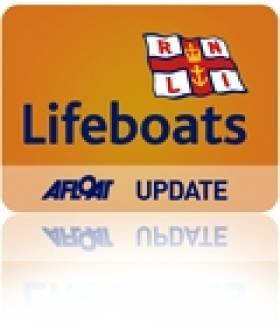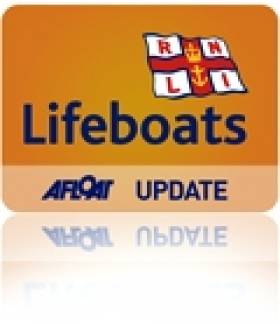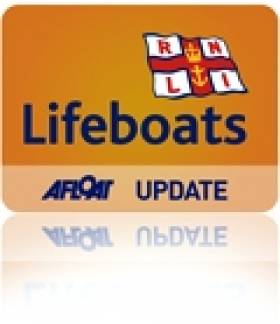Displaying items by tag: RNLI lifeboat
Body of Irish Fisherman Recovered in Scotland
#NEWS UPDATE - A fisherman whose body was found in a Scottish harbour on St Stephen's Day has been identified as that of a 34-year-old Donegal man, the Belfast Telegraph reports.
Philip Anthony Toland, from Glengad in Inishowen, Co Donegal, was last seen on Christmas Day near the pier at Ullapool harbour in the Scottish Highlands.
As BBC News reports, concerns were raised later that evening and a search was launched involving police, coastguard and RNLI lifeboat teams.
The body was located by a police dive team in the sea near the pier when the search resumed on Monday morning.
It is being speculated that Toland - who has an eight-year-old son - may have slipped and fallen into the water while returning to his boat.
Llandudno Lifeboat Celebrates 150 Years
The 30-strong crew of Llandudno RNLI are celebrating the 150th anniversary of their branch's founding.
"We are very proud to have reached this milestone," spokesman Alan Sharp told the Daily Post.
Since 1861 the Llandudno lifeboat has saved 550 lives from the Irish Sea off the coast of north Wales - many of them close to the town's renowned promenade.
The Daily Post has more on this story HERE.
Related Safety posts
RNLI Lifeboats in Ireland
Safety News
Rescue News from RNLI Lifeboats in Ireland
Coast Guard News from Ireland
Water Safety News from Ireland
Marine Casualty Investigation Board News
Marine Warnings
Portaferry RNLI Rescues Four from Fishing Vessel
The Portaferry RNLI lifeboat was involved in the rescue of four men from a fishing boat that ran aground off the coast last Monday evening, the Belfast Telegraph reports.
The lifeboat along with the Portaferry and Newcastle Coastguard and and Irish Coast Guard helicopter from Dublin responded to a distress call from a 60ft trawler that ran into difficulties close to Ardglass harbour.
All four men on board were rescued and treated by paramedics on scene, and the vessel was later refloated.
Related Safety posts
RNLI Lifeboats in Ireland
Safety News
Rescue News from RNLI Lifeboats in Ireland
Coast Guard News from Ireland
Water Safety News from Ireland
Marine Casualty Investigation Board News
Marine Warnings
Ballycotton RNLI lifeboat launched this afternoon to a 40–foot pleasure craft which has a foulded propeller, a mile east of Ballycotton lighthouse in East Cork. They are on scene at present (15:14) and are attempting to free the propellor. Update to follow.
Ballycotton RNLI lifeboat assists 31 ft. yacht
Ballycotton Lifeboat Launches Twice
An Garda Siochana received a call from a concerned woman who had observed a yacht struggling with its sail. She was unsure but was afraid that they may be having difficulties and in need of assistance. The Gardai contacted Ballycotton RNLI lifeboat station and 23:30 the Ballycotton lifeboat launched to investigate the report. After a short search they returned to harbour having satisfied themselves that all was in order.
A few hours later, at 04:10, they launched again. This time it was to a 44 ft fishing vessel with propeller problems 37 miles south east of Ballycotton. They are due to be with the casualty at 06:00 when a tow will be commenced. Conditions at sea are fresh and it will take approximately 6 hours to tow the vessel to harbour.
More to follow in due course.
Courtown RNLI officially name new inshore lifeboat
Courtown volunteer RNLI lifeboat crew and their supporters gathered today (Saturday 24 April 2010) to officially name their new IB1 lifeboat Cairde an Chuain. The name means Friends of the Harbour and was chosen in memory of Courtown lifeboat crew who have passed away.
The lifeboat and was made possible through a community appeal, which raised over €48,000 for the provision of the lifeboat and crew training. Members of Seafield Golf and Country Club selected the RNLI Courtown appeal as their chosen charity for a year and raised thousands of euro towards the cost of the new lifeboat.
Chairman of the RNLI Irish Council and Trustee for the charity, John Coyle underlined the importance of the lifeboat to Courtown, “ Every year sees an influx of visitors to this place, many of whom are drawn to the beautiful beaches and the great hospitality of the locals. We are fortunate to have a dedicated team of lifeboat volunteers on hand day or night to help those who find themselves in difficulty at sea. I wish Courtown lifeboat crew many successful launches and safe returns.”
Sam Kennedy, Courtown RNLI Lifeboat Operations Manager added, "We are extremely grateful to everyone who gave so generously to our appeal. This improved D class lifeboat will allow our volunteer crews to respond more quickly in emergencies and may well make the difference between life and death for someone in trouble on the water.”
Representatives from six families of crewmembers who have passed away officially named the lifeboat. Eileen O’Byrne, Eileen Redmond, James Sinnott, Linda Hurney, Mona Sheehan and John Redmond helped pour champagne over the bow of the lifeboat before it was launched into the sea and cheered on by the crowd.
Cairde an Chuain D711 has replaced D548 Star of the Sea. The previous lifeboat came into service in 1999 and was retired in August 2009. The new lifeboat is five metres in length and can take three crew onboard. It has a range of three hours at maximum speed of 25 knots.
Man wearing lifejacket is rescued from River Tweed
A man has been rescued from the River Tweed after falling from a ladder whilst boarding his angling boat. Lynda Bell, watch officer at Humber Coastguard says:
We received a 999 call at 11.40 this morning reporting that the man had fallen in the water and asking for assistance. The caller had heard the man shouting for help and we could still hear him shouting for help in the background as the 999 call was made.
“We requested the Berwick RNLI inshore lifeboat to launch and it was soon on scene picking the man up from the water.
"The 69 year old, who is from the Berwick area, was wearing a lifejacket so this meant that we were able to recover him from the water very quickly. He also did exactly the right thing by shouting for help as soon as he entered the water. After a quick check over by ambulance paramedics he was allowed home.
“This incident shows just how crucial a lifejacket can be. It can mean the difference between a swift and simple rescue or a protracted search with a possible fatal outcome. Please remember to wear your lifejacket. It’s useless unless worn.”
Courtown RNLI to officially name new lifeboat Cairde an Chuain
Courtown RNLI will hold an official naming and dedication ceremony for its new D-Class Lifeboat on Saturday 24 April 2010. The ceremony will take place at 2pm on the north pier in Courtown Harbour where the lifeboat will be officially named Cairde an Chuain (Harbour Friends).
The Courtown volunteer lifeboat crew and committee are issuing an invitation for everyone to join them for the ceremony. The new D-Class Lifeboat will have the number D711 and will be named Cairde an Chuain as a dedication to those volunteers of Courtown RNLI who have passed away.
Cairde an Chuain has replaced D548 Star of the Sea that came into service in 1999 and retired from service in August 2009. The funding for the new lifeboat was raised locally through various fundraisers and voluntary donations. The new inshore lifeboat costs €32,000 and is a significant investment in life saving.
Courtown Lifeboat Operations Manager Sam Kennedy said, “ Everyone with Courtown RNLI is looking forward to this important event. We hope that all our friends and supporters can join us on the day. A lifeboat naming ceremony is always a meaningful and memorable community event in the history of a lifeboat station. I know this new lifeboat will go on many successful callouts for years to come.”
Lifeboat Tows yacht off Rock in Roaring Water Bay
A 45ft wooden charter schooner went aground late yesterday afternoon in Roaring Water Bay, West Cork reports Sheela Broderick of Baltimore Lifeboat There were 3 men, 3 women and a young girl of preschool age on board at the time. The tide was falling so assistance was immediately required.
At 17:44, the Baltimore inshore lifeboat Bessie, was tasked to go to the assistance of the stricken vessel. Bessie is a twin-outboard Rigid Inflatable Boat that is capable of a top speed of 32 knots.
When the lifeboat arrived on scene, Helm,Micheal Cottrell, assessed the situation. The yacht was stuck fast on a rock on the North East corner of the East Skeam Island. A tow was passed to the schooner. Initially the inshore lifeboat attempted to pull the yacht off the rocks directly from behind, but the she did not budge. The vessel was listing 10 degrees on the rock, so it was decided to try a tow applied at right angles and this strategy proved successful in shifting the yacht from its perch.
The crew of the lifeboat then took 2 women and the little girl aboard as the journey time back to the yacht moorings at Sherkin Island was considerable. The lifeboat took the women and the little girl to Sherkin Island. The yacht was able to make her own way back to Sherkin with the rest of the passengers.
Lifeboat Crew: Helm - Micheal Cottrell, Ronan Callanan and Paul O’Driscoll.





































































